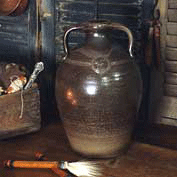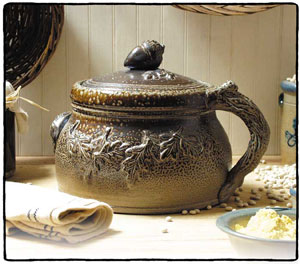|
An American Classic: The
Albany Slip Two-Handled Jug (2003)
Rowe Pottery Works, famous for
creating museum-quality reproductions of early American pottery,
now offers a limited production jug with authentic Albany Slip
glazing.
Albany Slip glaze was made from a
natural glacial clay discovered in Albany, New York in the early
1800s. "Slip Glaze" is the potter's term for a glaze made from
clay mixed with water.
Albany Slip glaze is characterized
by its deep-brown color. It was common on earthenware,
stoneware and salt-glaze pottery throughout the 1800s. It is
the natural brown often associated with bean pots. It can be
altered to produce a wide range of earth tones.
Durable and decorative, Albany Slip
was often used as an interior glaze on salt-glaze pottery. It
melted smoothly to form an impermeable glass coating, perfect
for storing liquids and for ease of cleaning. Its popularity
spread among potters throughout North America with the expansion
of the railroad system.
Once common, Albany Slip is now a
rare substance.
Much other clay was mined in the Midwest during this time and
also became known as Albany Slip, however, it is not true
Albany Slip clay. The
original Albany mine closed in 1986 due to difficulties in
extracting the clay. Since then, commercial supplies have been
exhausted. Only small stocks remain in private hands of potters
who treasured the colors of true Albany Slip.
Rowe Pottery Works is using
its own remaining inventory of true Albany Slip clay, one of the
last known stock, in making of this special historical Two
Handled Jug. In order to reserve our stock, we are introducing
only one Albany Slip collectible per year.
This jug truly represents a
bygone era of American pottery. It is an expression of the
quality and craftsmanship of Albany Slip pottery of the 1800s.
It is grand in size, holding approximately two gallons and
weighing more than 10 pounds. It is decorated with a primitive
bird sprig, a hand-combed pattern, two pulled handles and glazed
with true Albany Slip clay on the outside.
Each Jug will have a
variation of the "orange-peel" effect due to the salt glazing
process. This variation enhances the uniqueness of each pitcher
- no two will be exactly alike! A collector's treasure, this
showpiece will be available for a limited time.
Albany Slip Two Handled Jug - 15"H x 9"W
(Sorry -
Sold Out)
 Albany
Slip Bean Pot - Limited Edition for 2004 Albany
Slip Bean Pot - Limited Edition for 2004
The Albany Slip collection
continues in 2004 with the introduction of the Bean Pot. Third
in a series of handcrafted pottery decorated with true Albany
Slip clay and fired in the traditional salt-glaze manner. The
2004 Albany Slip Bean Pot comes with a recipe card for Grandma
Rowe's Beans and a Certificate of Authenticity signed by
Jim Rowe that includes the history of the bean pot and
the important relationship it had with the 19th century potter.
Albany Slip Bean Pot - 9"H x 12"W
(Sorry -
Sold Out)
The Potter and the Bean Pot
The potter has always been a valuable resource in rural
communities. Pottery was the most popular product produced by
the potter, but not the only one. Radiant heat created by the
wood burning kilns was a by product that was used by the women
of the community to bake beans. As we know, beans take many
hours to cook and since the potter would stoke his kiln with
wood for 24 to 36 hours at a time to reach the ideal firing
temperature, this created a great opportunity for beans to bake.
The bean pot shape was even created for baking next to a kiln.
It was made of stoneware that the potter crafted from clay he
gathered from a nearby riverbed or creek. The looped handle made
it easy for the potter to use his hooked rod to move the bean
pot from hot spots by the kiln. The properties of stoneware
could withstand the heat of the kiln and would help create an
even bake. The stoneware would also keep the beans warm long
after it was taken home. Rowe Pottery Works 2004 Albany Slip
Bean Pot is decorated with true Albany Slip clay and fired in
the traditional salt-glaze manner. Our craftsmen have added
original touches like oak leaves, acorn lid and bark lug and
handle to commemorate the forests that kept many of our
forefather's kilns burning for days on end. |

